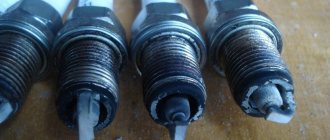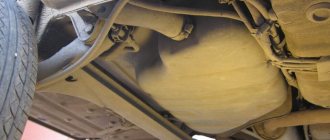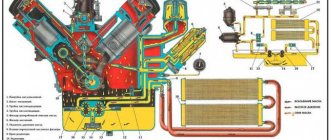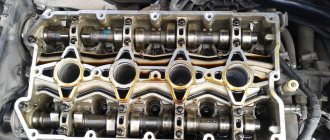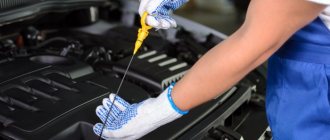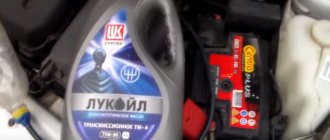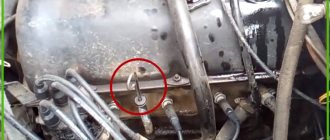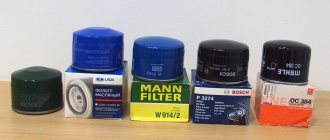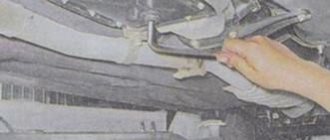Why oil gets in the air filter and what to do
The air filter is an important consumable component that protects key engine components from dirt, dust, stones, insects and other debris that can harm the stable operation of the engine.
The air filter should be changed every 10-15 thousand kilometers, or in accordance with the manufacturer's recommendations. When replacing, the driver may encounter the problem that traces of engine oil appear on the filter element.
In some situations, the driver pays attention to this due to symptoms of improper operation of the air filter, which has not yet completed its required mileage. It is prohibited to operate a filter that has traces of engine oil for reasons of safety of the car engine.
At the same time, installing a new filter element will not get rid of the problem, since after a few kilometers of run oil traces will appear on it. Before changing an air filter that has traces of oil on it, you should find the problem and fix it.
Oil in the air filter: reason
To fix a problem, you need to know its cause. There are several probable reasons, and all of them are related to wear and tear of the internal combustion engine.
Possible reasons for grease getting on the air filter:
- The walls of the oil deflector are clogged, there are oil residues in the crankcase, which, under the influence of crankcase gases, rise to the air filter.
- Due to damage or wear of the piston rings, they have become stuck. This led to the appearance of excess oil, which began to penetrate into the crankcase. The lubricant then flows into the oil slinger and onto the valves used for ventilation.
- The hoses through which crankcase gases exit the throttle are damaged or clogged. Engine oil particles go into the air purification system and end up exactly where you think - on the air filter.
- Air filter clogged. A worn filter cannot provide the internal combustion engine with enough air. Lack of air leads to suction in other places, including the crankcase. Naturally, after some time, oil stains appear on the filter.
“Experienced” drivers do the following: change the air filter, drive 3-7 thousand meters with it, open the lid and only then draw conclusions. It’s simple: there is no oil - the problem is in the filter, there is oil - which means the cause is wear of the elements of the cylinder-piston group.
Nature of the malfunction
The cause of oil getting into the air filter is the incorrect operation of the crankcase ventilation system. Crankcase ventilation is designed to reduce emissions of harmful substances into the environment. If you are familiar with the structure of an internal combustion engine, then you know that the tightness of the combustion chamber depends on several factors:
- total output of cylinders and pistons;
- condition of piston rings;
- tight fit of valves to seats;
- condition of valve guides and valve stem seals.
Since fuel combustion provokes a significant increase in pressure in the combustion chamber, even on a fully functional engine, a small amount of gases leak into the crankcase through the compression rings. Of course, in the same way, during the compression stroke, a portion of the fuel injection mixture leaks into the crankcase, which also adds gasoline vapor to the exhaust gases in the crankcase. In order not to release this mixture of oil vapors, fuel and exhaust gases into the atmosphere, modern cars use a closed-type forced ventilation system.
Design and principle of operation
The main principle of operation of the ventilation system is to supply gases from the crankcase to the intake manifold, where they will again be sucked into the engine cylinders. Ventilation is called forced ventilation because the pressure in the intake manifold is below atmospheric pressure, so gases from the crankcase are sucked into the intake manifold during the intake stroke. Schematic diagram of the system operation.
- Exhaust gases leak into the crankcase.
- A mixture of gasoline, oil and exhaust vapors enters the oil separator (oil particles settle on the walls and then fall back into the pan).
- After passing through the oil separator, the purified gases enter the intake.
- A mixture of clean air, purified vapors and gases is cooled in the intercooler, after which it enters the cylinders.
A valve with variable capacity allows for the removal of gases in proportion to their accumulation in the crankcase. As you can see in the figure, the system has a backup channel that bypasses the valve. Since our goal is to figure out how oil gets into the air filter and how to solve this problem, we will not delve into all the intricacies of the system’s operation, as well as its varieties.
Reasons why engine oil gets into the air filter
Fear when a malfunction occurs is understandable. The fact is that grease in the air filter is one of the signs of wear of the cylinder-piston group. It is often for this reason that buyers of used cars ask to inspect the intake. However, this is not the only symptom of piston wear - there are two more tools in the arsenal: and inspection of the color of the exhaust gases (a bluish color indicates oil burns).
Often, decoking of the piston rings, which is carried out without disassembling the engine, helps restore compression. But that’s not the point: compression and exhaust color are usually all right. What is the problem then? Willy Stutzer has collected all possible reasons for the appearance of oil in the air filter:
- The oil deflector located in the valve cover is clogged or faulty.
- The crankcase gas vent valve is faulty.
- The crankcase gas ventilation channel in the throttle assembly is clogged.
- Structural failures.
- Using HBO.
Oil deflector
Quite often the sealing elements of the oil deflector fail. For example, on a VAZ 21126 engine, part of the oil separator captures the oil filler neck. To prevent oil from the neck from entering the crankcase ventilation system, a rubber seal is used at the contact point.
At high speeds, oil from the camshafts enters the oil filler neck and flows down the walls. If the rubber ring becomes stiff, cracked, etc., then the lubricant will seep into the crankcase ventilation system and get directly into the intake tract.
To prevent the oil deflector from becoming clogged, you should change the engine oil in a timely manner and use only high-quality lubricant.
Crankcase exhaust valve
The operation of the crankcase ventilation system is controlled by a check valve. When there is a slight vacuum in the intake manifold, it is open. When there is significant vacuum at the inlet, the valve closes. If the valve is faulty, oil will inevitably enter the intake manifold body. The regulator may fail due to spring wear or coking.
Crankcase ventilation lines
There are cases when one of the lines of the crankcase ventilation system is clogged. For example, on a Lada Priora, the small branch channel, which is located in the throttle assembly, was clogged. Additional excess pressure forced crankcase gases through the valve along with oil, which settled on the air filter.
It is noteworthy that in such a situation, many motorists simply disconnect the hose from the throttle assembly, extend it and leave it in the engine compartment. The consequences of this decision are unstable idle speed and prolonged heating of the throttle assembly.
Design features
The dense layout of the engine compartment in some cases constrains engineers when designing the intake tract. A short intake and the proximity of the filter to the throttle valve disrupt the operation of the crankcase ventilation in some modes. Because of this, the presence of oil on the air filter of engines of this design is normal.
Where do traces of oil appear in the pipe?
At its core, there is only one reason why oil appears in the corrugation of the VAZ 2114 air filter - this is an excess of the normal gas pressure in the engine crankcase. As a result of this, along with the gases discharged from the crankcase into the pipe using a special tube (called a breather), suspended oil particles also enter. Once in the corrugation, they condense and settle on its walls.
Oil in the air filter pipe
There may be several reasons for excess pressure in the crankcase.
The main ones are:
- increased level of oil poured into the crankcase (higher than required);
- clogged or worn air filter;
- contaminated crankcase ventilation duct;
- an incorrectly functioning exhaust system (for example, the catalyst has melted);
- damaged main elements of the cylinder-piston group.
Problems with piston
Such diverse reasons for the appearance of oil in the pipe are due to the fact that the intake and exhaust processes in a car are very closely related and are designed for the presence of a certain pressure in all components of the system. As soon as one of its elements is damaged, it immediately affects all the others.
This is interesting: Painting a leather car interior: let’s take a closer look
How does oil get into the zero gear housing?
Now that we know the cause of such a malfunction, it’s time to find out specifically which parts of the engine may be to blame for this phenomenon.
The first thing to consider is the oil deflector. This device is designed to return oil particles during crankcase ventilation. If the oil deflector is covered with a sufficient layer of carbon deposits or is clogged, then the oil calmly leaves the engine along with the gases.
The next faulty item could be the oil filter. If it becomes clogged, the pressure inside the engine increases, which is explained by a lack of air in the crankcase. To prevent the engine from suffocating, it takes air from the gas that should have come out. This creates an incorrect vacuum that directs oil into the air filter element.
Piston rings can also cause oil to appear in the air filter. Their main task is to separate the engine lubrication system from the combustion chamber. With increased wear, this limit is violated. Some of the gases begin to flow from the crankcase into the power system, and from the power system, on the contrary, into the crankcase. Thus, too much pressure is generated inside the crankcase ventilation system, which presses the valve, and the oil again goes into the air intake system.
There is also a channel that is designed to relieve excess pressure from the crankcase. As a rule, it is called a breather, and the hose from it goes to the air purification system so as not to pollute the environment and heat the air in the filter. If the channel through which the breather is connected becomes too clogged with carbon deposits, then the pressure increases again, and then oil particles come out through it, which are sent to the oil filter.
Causes of leaks and how to deal with them
The most common is a simply dirty oil filter. It is so clogged that oil cannot seep through it. So before you delve deeper, remember when you changed it. If you are sure that the filter is clean, look for a harmful factor among the following. If the filter was changed recently and soon began to leak, most likely the rubber seal was not lubricated when installing it. When the filter barrier was twisted, it became skewed, and perhaps even deformed. The part is removed; if the rubber band is twisted, it is changed; if it is simply skewed, it is lubricated, and the assembly is put back together. A leak that appears immediately after changing the filter indicates that it is not seated tightly enough in place. It needs to be screwed all the way
Attention! This is done manually, without the participation of any tools. Otherwise, the seal will rupture and leakage will resume.
- The oil filter is damaged or was originally defective. There are no options here - replacement, and only replacement;
- Excessive engine oil pressure. It can be due to a number of reasons, the simplest (and most likely) being the production of lubricant. You will have to change the oil along with the filter;
- The bypass valve is broken. In different models it can be installed either in the filter holder or directly in the pump;
- We take the manual, clarify this issue and study the condition of the valve. If it is hopelessly jammed, you will have to change it, although there is hope of soaking it in a solvent - half of the wedges came apart after that;
- The thread of the fitting onto which the filter itself is screwed has been torn off. There is no way to tighten it completely; as a result, the oil is squeezed out. Replacing the fitting will fix the problem;
- The most difficult thing to solve is point 4. Most car owners still have to contact a service center to determine the reasons for the increased lubricant pressure.
Crankcase valve
One of the factors why the air filter is in oil is the failure of the crankcase ventilation valve. The idea is that the crankcase valve is connected to the air intake pipe via a rubber hose, which uses the engine's natural vacuum to prevent excessive pressure build-up. The valve must be replaced every time the car undergoes maintenance, but not everyone follows this rule and pays attention to it only after the engine begins to openly act up. This malfunction allows oil to pass through the valve, thereby contaminating the pipes and, directly, the filter.
In most powertrain assemblies, the crankcase ventilation valve can be removed by yourself. After dismantling, you should shake it, if you do not hear the characteristic crack of the check valve, this means that it may be the culprit of the oil leak. After replacing the PSV valve, the functionality of the entire system should be checked, usually this is done within 500-1000 km.
How to prevent oil from getting into the air filter?
There are ways to prevent it. But let’s say right away that oil on the filter most often appears on old cars that have run more than 150 thousand km. If the car is in poor condition, preventing the problem will be much more difficult.
What you need to do to prevent oil from getting into the air filter:
- Buy high-quality lubricant and change it promptly.
- Install a high-quality air filter from a trusted manufacturer.
- Pay attention to details such as the appearance of blue smoke, difficulty starting the engine and loss of power.
Visit a car service center for maintenance on time.
The effect of the air filter on fuel consumption
To achieve a noticeable effect in terms of fuel economy when using your car regularly, you need to keep your vehicle in good technical condition. Among other things, this is directly related to regular and timely vehicle inspection - after 10,000 km, the engine air filter needs to be changed.
Complete combustion of a combustible mixture is possible provided that it contains about 20 times more air than fuel. This device also affects the power of the motor due to the resistance created by the incoming air. The filter element can have a different design and, depending on the number of filtration layers, provide resistance to the flow of incoming air. An increase in power on sports cars can be achieved by installing filter devices with zero resistance.
Every day the number of such foreign objects increases, which is the result of poor air flow inside the power unit. There are seals placed around the accordion, the purpose of which is to block the passage of air into the engine, bypassing the filter. When replacing filters, the design of the vehicle must be taken into account. In cars with diesel turbocharged engines, the conditions for using the cleaner require its replacement at each oil change during maintenance. Experienced drivers recommend not saving on the cleaner, the quality of which affects the operation of the entire power unit. The cost of performing these procedures is much less than the work performed when a car engine fails.
During fuel combustion, oxygen is consumed (after all, without it this process is impossible). Over time, dust gets inside it. The motor cannot operate at full power. More fuel is consumed than with a new filter. In addition to the listed functions, the air filter also functions as a muffler.
Why does oil get into the air filter?
Engine oil in the air filter is a serious problem, which indicates the presence of damage to key engine elements, or their malfunction for one reason or another. If oil gets into the air filter, it most often happens for the following reasons:
- The oil deflector drain is clogged, which is why residual oil cannot return to the crankcase, and it will exit through the air filter along with crankcase gases;
- Piston rings are stuck, damaged or worn. This will prevent the rings from properly collecting excess oil that will begin to leak into the crankcase. Accordingly, dirty oil will begin to be squeezed out through the oil deflector and valves intended for ventilation;
If the driver has not changed the air filter for a long time, you should first make sure that the problem is not related to it. To do this, you will need to install a new filter element, drive several kilometers, and then examine it for oil stains. If oil continues to get into the air filter, more thorough engine diagnostics will be required to determine the cause.
Changing the air filter
Decided not to contact a car service and replace the filter yourself? Absolutely the right decision, because there are no difficulties in this process. You just need to prepare:
- Screwdriver Set;
- new air filter;
- vacuum cleaner.
First you need to know that the Priora air filter housing is installed in the engine compartment, near the battery. To replace it, you need to open the hood. The further sequence of actions is as follows:
Disconnect the connector from the mass air flow sensor (MAF). It will interfere with operation, so press its latch and disconnect the wires. Use a Phillips screwdriver to remove the screws that secure the air filter cover. Remove the cover. Bend back the bellows of the Lada Priora air filter. Remove the worn-out old filter element. It is not secured by anything and is held in place only by the frictional force of the rubber seal. As you can see, removing the air filter is a very simple task. Assess the filter surface. It is usually clearly visible when the cleaning element is quite clogged, since its surface is completely covered with dust. Know that this is not a sign of a malfunction. Much more important is how clogged the pores of its filter material are. This is what affects the overconsumption and drop in engine power. Vacuum the installation area from dirt, sand and dust. Having oriented the new filter according to the inscriptions on its surface, install the new part into the housing
Pay attention to the location of the filter pleats. They must be parallel to the longitudinal axis of the car. Make sure the filter rubber fits snugly against the edges of the housing.
Otherwise, fix it or replace it if it is damaged. Reinstall the Priora air filter pipe. Close the air filter housing cover. Tighten the four screws that secure it. Connect the wiring harness with the connector to the mass air flow sensor.
When replacing the filter element, you should definitely pay attention to one point, namely, whether there is any engine oil in the air filter. The presence of lubricating fluid on the surface of the housing or filter element may indicate an impending repair (weak compression, loss of elasticity of oil seals, etc.
etc.), and a banal malfunction in the form of a clogged breather.
The crankcase gas exhaust channel must be cleaned immediately, because a clogged breather can cause oil to leak through the oil seals and engine seals due to increased gas pressure in the crankcase.
Why does oil get into the air filter?
There are 4 most common reasons why oil leaks into the air filter:
- Heavily worn and coked piston rings. Because of this, excess lubricant is poorly removed from the cylinder walls, and some of it ends up in the crankcase.
- The throttle hose for crankcase gases is clogged with dirt.
- Clogged oil deflector drain. The remaining liquid cannot flow through it back into the crankcase, and the oil mixed with gases floods the air filter.
- Critical contamination of the filter element, due to which it loses its quality and does not allow air mass to pass inside the engine in sufficient volume. To compensate for the lack of air, the engine begins to suck it from the crankcase.
The result is always the same - the air filter fills with oil. What to do if motor lubricant is found in the cleaner?
Do I need to replace a worn or damaged pipe?
Some motorists believe that you can drive with a cracked pipe, but this position is fundamentally wrong. Firstly, a damaged pipe will not be able to supply clean air to the engine. After all, through the gap, air from under the hood will enter it, which has not been filtered, and therefore carries abrasive particles (which, as mentioned, can quickly damage the engine).
Replacing the pipe
Secondly, driving with a damaged corrugation also leads to faster wear of the air filter; it will have to be changed much more often. That is why a damaged or worn pipe should be immediately replaced with a new one.
What to do to prevent oil from getting into the air filter
The problem with oil getting into the air filter is typical for older engines that have traveled more than 150-200 thousand kilometers. To delay as much as possible the moment when engine oil begins to enter the filter element, it is recommended to properly monitor the engine:
Buy high-quality oil recommended by the car manufacturer. Remember that motor oil from major brands is often counterfeited, so you should purchase the fluid from reputable stores;
High-quality consumables are the key to the “health” of the engine. It is better not to skimp on oil, gasoline and filters so that the need for major engine repairs does not appear too early.
A part such as a car air filter performs a very important function. It serves to clean the air entering the engine, necessary for the formation of the fuel mixture, from various pollutants (litter, sand and other abrasive particles). If air that has not undergone such purification enters the engine, the cylinder walls may be subject to rapid wear, and the engine itself will ultimately fail.
It is to transfer such purified air from the filter to the engine that the VAZ 2114 air filter pipe, which has the form of a corrugated channel of complex shape, is used.
The most common type of damage to this part is mechanical, most often ruptures of the outer shell. Their reasons are simple and understandable, but sometimes troubles arise that make the car enthusiast much more worried - such as oil getting into the filter bellows.
Here are the main signs that the air filter in your car has become unusable.
So keep in mind that the air filter replacement interval depends on many things. Therefore, each car owner must set for himself the frequency of filter replacement. The main thing is not to operate the car with a dirty filter, as this is fraught with problems with the engine in the long run.
Any car enthusiast can replace the filter if he has a standard set of tools. Unscrew all the bolts that secure the air filter housing cover and remove the cover itself. Try not to shake it or allow any other dust to enter it. Wipe the installation site for the new filter and lubricate its seat with pre-prepared lubricant. After this, all that remains is to connect the battery terminal and continue operating the car.
You can extend the life of the air device by using a fabric filter placed on it (for example, a piece of gauze of sufficient density). Until recently, clogged paper filters were washed and reinstalled in the engine power system. There are approximate terms for replacing the filter, but it all depends on the degree of contamination. Having covered this distance, the vehicle owner can change the filter or check the data in the registration certificate (it contains a mark indicating the end of the filter’s service life and its replacement). You can simultaneously install a new filter and change the oil when the car has traveled 10-15 thousand kilometers, or do it every other time in order to save money.
It’s very simple - from the information I said just above, it follows that the filter element is simply an obstacle to the air and when the piston goes down, it must suck it in with force! Often even the engine does not start well. Just imagine this is an ordinary filter element, which essentially costs a penny.
For passenger cars, compact devices with a limited working surface are used. And the sizes of air filters for special-purpose vehicles, buses, and trucks are correspondingly larger, since they have to clean large volumes of air. It is worth noting the differences in car air filter housings.
Oil in the air filter. Why? And also the causes and consequences
Almost every vehicle owner sooner or later encounters a situation where oil appears in the car’s air filter. This problem occurs especially often in cars with significant mileage, in which the engine is not in the best technical condition. Of course, new cars will not have this problem! But if your mileage goes beyond 200 - 300,000 kilometers, then anything can happen. In general, for those who already have oil, and for those who just want to know, this article...
Let’s try to figure out what reasons lead to lubricating fluid getting into the car’s filter system and what consequences may arise from this. To begin with, guys, I would like to note that these are often really complex breakdowns, so you need to operate the engine correctly, namely, pour good oil and it is advisable to change it more often. Also, use only proven fuel, do not pour “surrogate” at strange gas stations.
Getting rid of oil in the filter
In order to make sure that oil does get into the filter (or this option is excluded), we recommend conducting an experiment: the crankcase air ventilation outlet must be extended so that it passes below the engine. If after some time the filter is clean, then the problem lies in the ventilation system itself, so you cannot delay in identifying the problem and repairing it.
One of the common practices among drivers when removing oil from the filter is to carefully remove the tube from the breather. The hose is suspended and routed under the bottom. Despite the effectiveness of this method, it should be remembered that its use lengthens the process of warming up the throttle assembly in frosty weather by an order of magnitude.
You can also solve a similar problem by installing another oil deflector under the cylinder head cover. It can be used as a scourer for cleaning the throttle valve, made of metal. You can purchase this simple tool at almost every hardware store. After this simple procedure, the idle speed will become more even, and the problem will disappear by itself.
The most dangerous reason for the appearance of oil in the filter is compression difficulties; all other cases are less serious. However, this does not mean that you can treat them carelessly and not delay troubleshooting. Negligent attitude towards such a malfunction can completely “kill” the engine. Then the driver will have to fork out heavily for major car repairs.
If you want to protect yourself as much as possible from the negative effects of oil in the filter, then regularly carry out preventive maintenance, which does not take much time and is simple. Inspect and evaluate the components of your car to be able to identify the problem at an early stage and quickly deal with it.
For example, if during the next inspection of the filter you find mechanical damage or there are breaks in the cartridge, then immediately replace the filter. The filter should be selected individually, in accordance with the characteristics of the engine of your car.
In conclusion, we would like to add that timely replacement of filters will save you from various types of malfunctions and save a lot of financial resources and effort required for auto repair work. Remember that replacing the filter early can be just as destructive as replacing it late, especially if we are talking about a “wet” filter.
Reasons for the appearance of oil in the air filter. How to fix it?
Probably, many car owners have encountered such a problem as the presence of oil in the car air filter. Oil getting into the air filter can cause serious damage to your car, but there is no need to panic. Things may not be so fatal. Today we will look at the main reasons for oil getting into the filter and ways to solve this problem.
Troubleshooting
One of the possible reasons for oil getting into the filter is too much pressure from the crankcase gases inside the pipe through which they move. If, after disconnecting it from the system, you notice an oily substance inside, then there is a high chance of oil from the hose getting directly into the air filter. In this case, disconnect it completely and wash it with water.
Next, be sure to check the throttle valve. Especially if the engine speed has dropped sharply, especially if the car has stalled. When you remove the throttle, you will most likely notice the small branch channel clogged with soot. In this case, the pressure in the gas exhaust system usually increases, which leads to squeezing out the lubricating components through the seals. In addition to completely cleaning the throttle, you can install another oil deflector under the valve cover. As a result of these actions, the engine idle speed comes into balance, the engine calms down, and of course, the problem described above disappears.
Another reason for oil expulsion into the filter is carbon deposits on the main oil deflector. Experts advise checking this part of the car and, if dirty, clean it properly, and perhaps even replace it. It is also advisable to clean or change the air filter itself properly.
After all the above procedures, you need to walk about 400 - 500 km. Then be sure to repeat the diagnosis.
If there are more serious problems
If there is oil in the air filter pipe, it is advisable to check the pressure in the engine cylinders. If the compression is different and reaches more than one atmosphere, then, alas, your engine has reached its potential. Although, perhaps, this is due to the wear of the low-removal rings, which is also a rather serious problem.
The valves will also require checking, since their incorrect operation can cause oil to escape into the filter. Don't forget to look at the engine crankcase seals. If they are severely worn, oil-containing materials can also enter the air filter pipe.
What you can do yourself
Small problems can be easily eliminated, but when oil continues to get into the filter, there is no way to do without a major overhaul of the power element of your car. First of all, oil seals and low-removal rings must be replaced to prevent oil leakage through cracks when they are heavily worn. Sometimes engine pistons and valves need to be replaced, which takes a significant toll on your pocket. The air filter and oil purifier are also replaced.
Overhauling an engine requires considerable expense, but there is a way to delay this process. If you're ready to get started on engine rebuilding, here's what you'll need to do:
— disconnect the crankcase gas supply hose
- close the fitting in such a way that the breakthrough of oil and gases through its opening can be avoided
— ventilate the crankcase by passing an extended hose under pressure
It is advisable to engage in this practice avoiding the winter period. Another important point is the mandatory oil change after the procedure.
What else can you do
Of course, by doing all these steps you can significantly improve the situation, but when the reason is engine wear, there is only one option left - a major overhaul. All this will require a lot of money and time, for which we really hope you will be ready. The most important thing is to trust a professional and move forward to a bright future with a completely overhauled engine!
What affects the quality of air purification?
These processes occur slowly, however, reducing the service life several times. On serious sports cars, this problem is not relevant, because the operating mode of the engine is such that it cannot withstand even 10 thousand kilometers.
As noted above, it is almost impossible to significantly extend the service life of the filter element. The only recommendation that can be given in this case is to maintain cleanliness in the engine compartment, because the dust accumulated there also goes into the filter while driving. This practically guarantees that the consumable will last until the next scheduled replacement without causing problems.
The air filter is an important part of the car and its importance should not be underestimated. One of the most important reasons to regularly replace your car's air filter. In more modern fuel-injected vehicles, the air filter is usually located at the top front or side of the engine near the throttle body. A dirty air filter may appear clean, but it still needs to be replaced after the specified interval. The new air filter will reduce fuel consumption, reduce harmful emissions, optimize air flow and improve engine performance.
The main disadvantage of nuleviks is the reduction in engine life by 3 to 10 times, depending on driving style and engine operating modes. To seriously increase the engine's power, it will need to be completely rebuilt.
Please note: similar to the air filter element, the fuel filter affects fuel consumption. Fuel filters are also sensitive to fuel quality and prevent harmful impurities from entering the tank during refueling.
Replacing dirty, worn filters does not take much time and is inexpensive.
How does the degree of pollution affect power? And in accelerating mode, fuel consumption is several times higher than during uniform movement. There is an opinion that as it gets dirty, the filter cleans the air better. However, this is not quite true. The pockets and microchannels in the filter paper become filled with dust particles over time, causing the filter's throughput to decrease. But since greater vacuum is created in the intake tract, especially at high speeds, air still continues to be sucked in, breaking its way through clogged channels.
Pressure reducing valve
In most cases, if the oil is in order and there are no complaints about the filter, it turns out to be the culprit. We considered this option in paragraph 5 (bypass and pressure reducing valves are the same thing). If he turns out to be the culprit, then the visit to the service station can be postponed: checking and replacing it is available for independent execution. All you need is a set of keys and old rags.
- The timing belt cover is removed;
- The plug is unscrewed from the bypass valve;
- The spring is removed from the socket. It is responsible for the operation of the valve, and its integrity ensures the release of excess pressure;
- The spring is carefully examined. There should be no nicks or other damage on it. Creases and kinks are also not allowed;
- The coils should be tight; If the spring can be easily stretched with your fingers, metal fatigue is evident. The height of the element must be strictly 44.72 mm. A lower value indicates that part of the spring has been broken off for some reason. In this case, take the trouble to remove the fragment from the nest so that it does not spoil your picture in the future. If the spring does not meet specifications, it should be replaced.
In principle, there are no other reasons in nature why oil squeezes out and flows from under the oil filter. If the bypass valve is in order, the filter is installed correctly, the seal is lubricated and intact, and the oil continues to press through, think about changing the manufacturer of the filter element: most often this is due to poor quality.
Signs of excessive filter clogging are an over-enrichment of the fuel mixture due to poor air permeability of the filter. When removing the filter from a running engine, the speed increases (the permeability is already poor, the membrane is clogged). The first sign is the appearance of the air filter; if it is dirty, dusty, or the pores are clogged, then it needs to be changed urgently. The second sign is changes in engine operation: the engine begins to operate unstably at idle, engine power drops, and excess fuel consumption appears.
Eliminating the causes leading to the appearance of oil in the pipe
Factors leading to an increase in crankcase gas pressure and, as a consequence, to the appearance of oil in the air filter duct were discussed above. The first of these is a high level of lubricating fluid in the engine crankcase. When the oil is above the maximum level, the internal free volume of the crankcase decreases, which leads to an increase in pressure in it. In this case, it is necessary to drain the excess and subsequently try to maintain the engine lubrication level in the middle between the MAX and MIN marks on the dipstick.
When the air filter is clogged, this not only leads to a decrease in engine power and the possibility of a number of other malfunctions, but also to a change in pressure in the crankcase. When the motor does not have enough air, excess pressure is created in the air supply channels. If all connections are sufficiently sealed, then the missing volume of gas is sucked through the breather connected to the filter pipe from the crankcase. So in this case, oil vapors enter the air duct. A simple and quick way out of this situation is to replace the air filter (if it is really dirty and the reason for the appearance of oil in it).
It is clear that if the crankcase ventilation system (channel) does not work (clogged), then there will be increased gas pressure in the latter. We are talking about special channels in the cylinder block and a thin hose between the throttle valve and the valve cover. These means of crankcase ventilation tend to coke if low-quality or old oil that is not replaced on time is used, which begins to lose its properties, turns into a resin state and clogs the internal lumen of the channels. Also, in winter, in severe frost, these crankcase ventilation systems can freeze - accumulated condensate gets trapped in them.
In the latter case, it is enough to run the engine at idle speed and it is better to do this as a preventative measure for about half an hour each time you start it in the morning. If the ventilation channels are clogged with dirt and oil, you will have to clean and rinse them. Start with the tube between the throttle body and the valve cover. If this does not help, you will have to open the engine and clean the channels in it. It is better to entrust this work to specialists.
The case where the cause of oil getting into the pipe was an exhaust system clogged with molten catalyst is extremely rare. It is described only once and for the VAZ 21124 car. The author (owner of the car) of this story claims that in his car the air filter itself was filled with oil. After all the washing and cleaning of the engine, adjustment and replacement of some parts, no changes occurred. There was no time to disassemble the engine itself, since it did not smoke, although it was dull, it ate a lot of fuel, and besides, a melted catalyst was suddenly discovered. After cleaning the exhaust system, according to the author, the car began to work perfectly and the air filter pipe has not been contaminated with oil leaks since then.
Replacement frequency
To fully understand the need to replace the Priora air filter, let's imagine a situation: the filter is so clogged that it passes only half the required volume of air required for fuel combustion. What happens in the cylinders when the mixture is ignited?
An incorrectly prepared air-fuel mixture will not burn completely, because complete combustion of a certain amount of gasoline requires an appropriate volume of air. In this case, a considerable portion of the fuel will simply fly out into the chimney, and, accordingly, the engine will lose power.
The price of a Priora air filter is not so high that it would be so wasteful to waste expensive gasoline. It’s easier to replace the part and enjoy the efficiency of this car. The manufacturer recommends changing the air filter of the Lada Priora every 30 thousand kilometers.
However, many car enthusiasts replace the filter element much more often. And it is right. Agree that driving through a relatively clean city and dusty country roads are completely different conditions in terms of the load on the filter element.
That is why you need to decide for yourself when to replace the air filter of the VAZ 2170 Priora. Dusty and dirty roads, poplar fluff - all this should speed up the replacement process much more. If your car only goes on stage at a local theater as a prop, then perhaps you can listen to AvtoVAZ’s recommendations. Do you use your Lada in other conditions? Then change the filter at least every 15 thousand km.
Briefly about the prevention of ICE
In conclusion, we will consider some aspects of preventive measures designed to prevent the moment when the car’s air filter fills with oil due to defects in the cylinder-piston group. Their essence lies in the following points:
- Change the lubricant more often; if the manufacturer recommends, for example, changing it after 15,000 km, then you do not need to maintain this particular interval - it is better to change it after 10,000 km. The fact is that the timing depends on many parameters, including seasonality, operating conditions, and the quality of fuels and lubricants.
- Purchase only certified lubricants.
- Be sure to combine an oil change with the installation of new air and oil filters.
- Use only high-quality fuel from proven brands.
These simple rules will improve the performance of the motor and also increase its service life. It would not be superfluous to install a universal oil catcher on the crankcase gas supply tube. Its price is low, but the effect of its use will not be long in coming - the filter element will be reliably protected from lubricant penetration.
The air filter is an important consumable component that protects key engine components from dirt, dust, stones, insects and other debris that can harm the stable operation of the engine. The air filter should be changed every 10-15 thousand kilometers, or in accordance with the manufacturer's recommendations.
When replacing, the driver may encounter the problem that traces of engine oil appear on the filter element. In some situations, the driver pays attention to this due to symptoms of improper operation of the air filter, which has not yet completed its required mileage. It is prohibited to operate a filter that contains traces of engine oil for reasons of safety of the car engine. At the same time, installing a new filter element will not get rid of the problem, since after a few kilometers of run oil traces will appear on it. Before changing an air filter that has traces of oil on it, you should find the problem and fix it.
